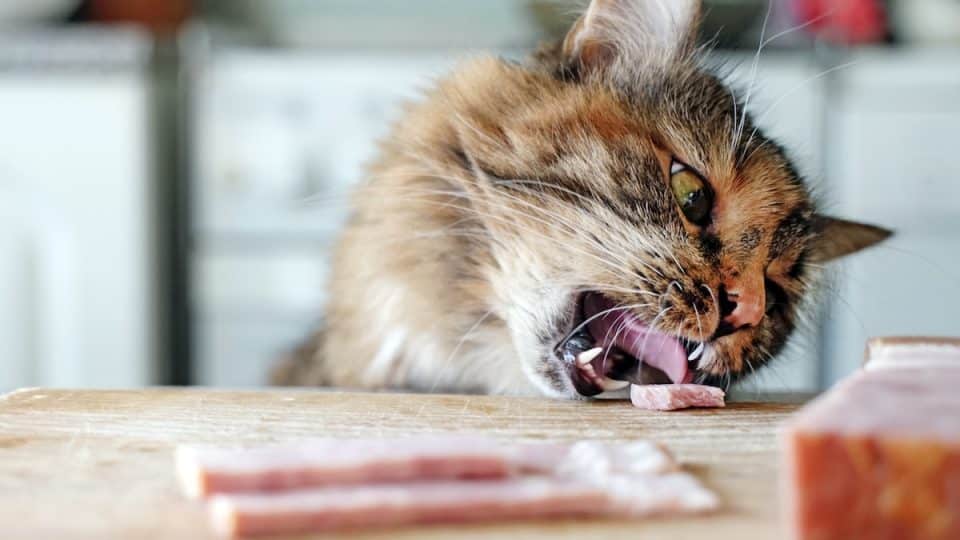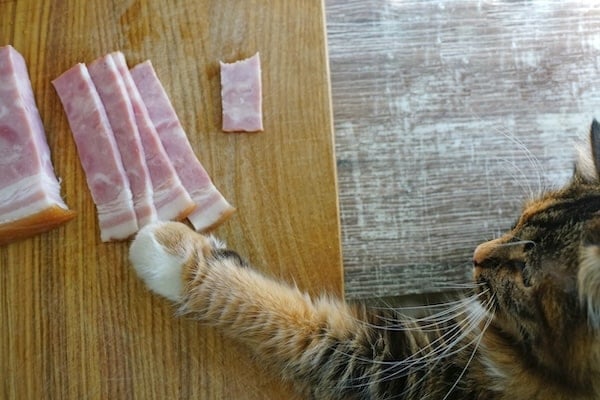Whether you’re enjoying a protein-packed sandwich or a delicious holiday feast, ham is a favourite food for many. And if your cat takes an interest, you might wonder if it’s okay to share a bite.
Cats are carnivores by nature, so it seems natural to let them nibble on this food derived from the hind leg of a pig. But modern domestic cats process many foods differently than their wild ancestors. And due to the ingredients in many processed hams, consuming a portion too large can wreak havoc on a feline’s fragile digestive system.
“It can be okay to feed a cat ham in very small portions,” says Dr. Kathleen Mottel, Assistant Managing DVM at Glen Ellyn Animal Hospital. “But it’s important to know that too much can cause stomach issues and, in some cases, pancreatitis due to high levels of salt.”
Before you consider feeding this meat to your cat, here’s what you need to know.
Which Types of Ham Can Your Cat Eat?
While cats can often safely consume small quantities of lean, cooked, unseasoned ham, other preparations are less digestible for them. Always double-check that your ham passes the kitty safety test:
| Type of Ham | Safe for Cats? | Reason |
| Plain, cooked ham | Yes, in small amounts | Offers a good source of protein but is high in sodium. This is best used as a small, occasional treat. |
| Deli ham | Yes, in small amounts | While the occasional bite of deli ham usually won’t upset your cat’s stomach, the high sodium and additives can pose health issues in greater amounts. |
| Sliced ham | Yes, in small amounts | A small piece of one of these thin slices can be a nice, protein-packed treat for kitty. Just be mindful of portion size! |
| Country ham | No | Known for its salty, smoky flavour, country ham makes for a delicious human meal! Cats, however, won’t be able to digest this high-fat, high-sodium meat well. |
| Uncooked gammon | No | Gammon is the raw, cured hind leg of a pig. Consuming raw meat can pose dangers to felines and humans alike. Avoid feeding your pet any meat that isn’t cooked. |
| Ham bones | No | Avoid letting your cat gnaw on ham bones. This poses a choking hazard and can cause damage to the digestive tract. |
Pro tip: Bacon lovers might wonder if this crispy, sizzling breakfast favourite is safe for cats to try. The sad answer is no. This type of cured pork also contains high levels of sodium and fat, which can be a health hazard for cats.
-
Natalia POGODINA via iStock
Why Ham Can Be Bad for Cats
Cats can eat some ham, but should they? A nibble of plain lunch or deli ham is usually okay for cats, but too much ham is likely to cause problems. “Eating [too much] ham can cause an upset stomach, vomiting, diarrhoea, and even pancreatitis,” says Dr. Mottel. “It’s also a food that’s high in fat, which can cause weight gain and health issues associated with excessive weight.”
Cats can have trouble digesting meat with seasonings and cooking oils, resulting in an upset stomach. Pet parents will want to avoid letting their cat eat ham cooked with onions or garlic, as these ingredients are toxic to felines.
A balanced diet is crucial to a healthy nine lives. If you catch your cat curiously nibbling a tiny bite of ham, they’ll likely remain unscathed. If they’ve eaten a whole piece or a large amount, watch out for signs of illness and contact your vet with any questions.
Can Kittens Eat Ham?
Typically, kittens can begin eating solids around 3 to 5 weeks of age. Young cats have an extremely fragile digestive system, so it’s important to avoid feeding kittens salty, fatty foods as much as possible.
Too much sodium can cause issues for a kitten’s delicate stomach, so it may not be worth offering ham as a tasty treat until your cat is a bit older. Instead, provide nutritious kitten-specific food to help them grow and develop.
How Much Ham Is Safe?
Letting your healthy adult cat snack on a tiny bit of lunch ham or a small, plain ham cube can be a fun way to provide your pet with a delicious treat. Offered infrequently and in small amounts, a little ham shouldn’t be a problem, though it’s best to avoid feeding ham to cats with preexisting digestive issues.
If your cat is craving more ham than you can safely provide, consider some healthy alternatives. “Regular cat treats and wet treats are a great way to reward your cat safely,” says Dr. Mottel.
To add some additional diversity to your cat’s diet, consider making homemade cat snacks.




